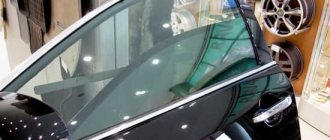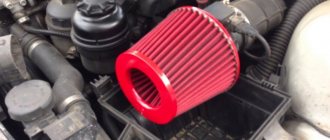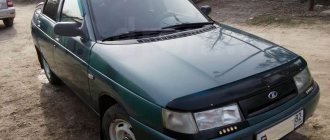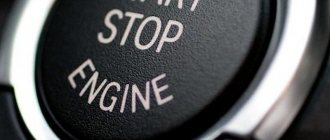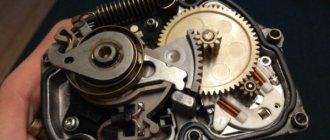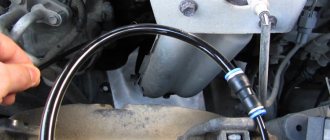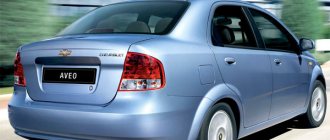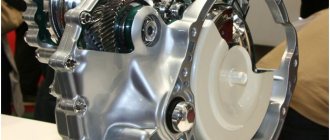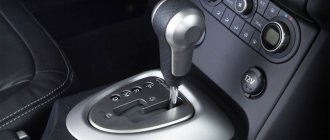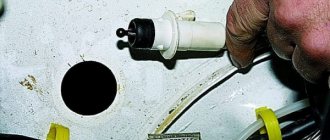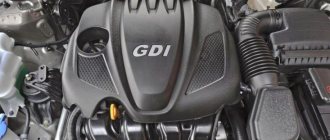Why block him?
In certain situations this is necessary. To make it clearer, let's look at everything in order. If a car turns sharply or goes over rough terrain, its drive wheels travel different lengths. For example, when turning, the path of the outer wheel will be longer, and the path of the inner wheel will be shorter. Previously, when car speeds were low, this circumstance did not particularly worry anyone. But gradually the speed of the cars increased, and problems began to arise:
- tires wear unevenly;
- handling is seriously degraded.
All this happens due to the fact that the torque on the drive wheels of the car is always the same. Therefore, it became necessary to separate the drive wheels so that each of them had its own torque. This task is performed by the VAZ 2107 differential. If the road is smooth, there are no problems with this unit. But as soon as the car finds itself on rough terrain with the differential engaged, the wheels begin to slip, and driving the car becomes much more difficult. It is in this situation that the driver should lock the differential to increase the vehicle's maneuverability.
Bearing wear.
Another common cause of gearbox noise is bearing wear. Only, unlike worn gears, the gearbox does not hum for long due to the bearings. The bearings are destroyed, and the gearbox housing is often damaged. So if it starts to buzz, there’s no point in delaying repairs. Repairs will be much more expensive later. When reassembling, the bearings must be inspected very carefully. A typical symptom is pitting on treadmills:
Of course, such a bearing is immediately obvious that it is discarded. But you need to carefully examine those that seem good, and change the slightest spots too. However, keep in mind that not all bearings are equally durable. The weakest is of course the rear input shaft bearing. In the photo there are just clips from this one. It works when the engine is running, regardless of whether the car is stopped or not, but most importantly, when accelerating, it has the same speed as the engine. In addition, the more intense the acceleration, the greater the load on it. This bearing is subjected not only to radial but also to axial loads. The teeth of the gears are oblique and under load the shaft tries to move in the longitudinal direction; only this bearing keeps it from shifting. Well, the bearing is held in one direction by a locking ring, and in the other by a locking plate. I would like to note that in similar boxes of famous foreign cars, such units use conical rollers or structures with thrust bearings that can withstand much greater loads. In second place in terms of frequency of breakdowns, I would put the same 305th bearing, which is installed on the secondary shaft. Therefore, if you want to make a good box, it is better to replace these two, as well as the seals, with new ones, regardless of the condition. Of course, provided that these new ones are of high quality, because the new ones can be even worse than the old ones. Next is the roller bearing at the front end of the secondary shaft. This one is already quite reliable, although recently it also happens that it breaks down, usually with a crankcase rupture. Well, the most reliable are the front input shaft and differential bearings. They very rarely require replacement. Therefore, if they look decent, you can safely leave the old ones. A few more words on the choice of bearings. The ones from Vologda are usually considered the best, but in fact, among them there are also often defective ones. On boxes new from the factory, they can start buzzing after fifty thousand. In fact, choosing a bearing is a lottery; if you're lucky, it will last a long time. As for roller ones, I don’t recommend using the ones in the photo on the right:
You see, the rollers are smaller in size and number. These are very short-lived, but this is understandable; small rollers will not be able to bear the same load as the original bearing. Also, do not forget to check the steel plate that secures the rear bearings. Very often a deep groove appears in it; if the hole is not significant and there is no new one, you can push it down a little with a hammer. It is made of mild steel, the main thing is that this plate presses the bearings:
Types of blocking
There are three of them: manual (forced), automatic (self-locking differential) and partial.
- The driver turns on the manual locking himself when he finds himself on rough terrain. It's simple: a switch is pressed in the cabin, after which a special limiting unit begins to operate, preventing torque from being distributed to the drive wheels depending on the path they travel. The advantages of such a lock are obvious: the driver himself decides when to engage the limiting mechanism, and the rest of the time this device does not work and, accordingly, does not wear out. There are also disadvantages: to lock the differential manually, the driver will have to take his mind off the controls. And he gets distracted in extremely difficult road conditions. The driver should also not forget to disable the lock when he is on a flat road. If you don't do this, you can break the differential itself. And finally, you will have to install not only the limiter itself, but also the system that will operate it, which is associated with certain technical difficulties.
An example of forced differential locking on VAZ and Niva cars
An example of a finished lock on a VAZ from Val-racing
Explanation of operating principle
Translated from Latin, differentia means “difference.” In a car, a differential is a mechanism that distributes torque to the car axles. It definitely exists in every car. A simple differential is called classic, open or free.
Let's imagine that the rear axle gearbox does not have a differential, but there is a single axle, like a tricycle.
Since there is no absolutely linear movement, and the driver's hands almost never lie motionless on the steering wheel, it is clear that the path of the drive wheels will be very similar, but slightly different.
If there were no differential, then the path of the left and right wheels would be the same. Then constant slipping will become inevitable, since a common trajectory is “imposed” on the wheels. This results in increased tire wear and rapid failure of transmission units.
The task of the gearbox is to give the wheels independence and “freedom”, to separate their rigid connection.
How does a classic differential work?
If there is one drive axle (all VAZ classics), then one gearbox is required between the rear wheels, i.e. interwheel. In the case of a full-fledged jeep, there are as many as three differentials - two inter-wheel differentials for each axle, and an additional inter-axle one.
This mechanism (also called a gearbox) is installed in the rear axle housing. The drive gear transmits torque to the driven gear. It is distributed into two gears of the axle shafts, and they rotate the wheels.
Additional gears - satellites are a symmetrical equal-arm lever, and transmit forces equally to the wheels.
When the car moves in a straight line, the satellites do not rotate. As soon as the car slides onto uneven ground or enters a turn, that is, when each wheel has its own path, the satellites begin to rotate and redistribute the torque between the wheels of the drive axle, and to the axle shaft that has less resistance and is easier to spin.
The VAZ differential is shown in the figure below:
8 — axle gear; 9 — satellite; 11 — driven gear of the main gear; 18 — drive gear of the main gear;
This is how the satellites behave and distribute the moment of movement in different areas:
- straight movement - turn left - right wheel slips
From the analysis of the rotational speeds of the axle shafts and gearbox it follows that:
- If one wheel is stationary, then the free wheel rotates “for two”, and the rotation speed is doubled.
- If one wheel slips, it spins faster and starts to slip, and the second wheel with good grip will receive the same torque, since it is distributed equally, and the differential cannot give it all the traction.
- If the traction of a single wheel becomes less than the resistance to movement, the car will stop.
- In this case, the situation of point 1 arises, the running wheel stops, and the previously slipping wheel sharply increases speed.
- When you try to “add gas,” the speed of the slipping wheel increases.
So, a conventional gearbox does not help the drive axle on slippery roads and on surfaces with high rolling resistance (snow, sand and mud). The cost of a conventional gearbox is about 5,000 rubles.
Which one to choose for VAZ 2107
The answer to this question directly depends on the operating conditions of the vehicle. If the car owner never goes into the city and moves exclusively on country roads and rough terrain, a full manual differential lock is suitable for him. If the driver drives around the city, but the quality of the roads there leaves much to be desired, it makes sense to opt for automatic disc locking. Finally, if a car owner drives on good city roads all year round, a partial differential lock mechanism is quite suitable for him. The best devices of this type are produced by Quaife, Lokka and Torsen. These are expensive components, the installation of which is best left to qualified specialists. At the same time, you can do simple blocking yourself. This is exactly what will be discussed below.
How to do
The easiest way is to permanently lock the differential completely. But such a homemade blocking is acceptable for cars driving only off-road. For example, for rally-raid cars. To implement the idea, you need to remove the unit equipped with the differential and disassemble it. Then weld the satellites to the axles. Fixing the gears will allow the mechanism to divide the rotation speed between the axle shafts only in a proportion of 50 to 50.
Making a limited slip differential with your own hands is a little more difficult than simply fixing the satellites. But such a modernization will not only improve the vehicle’s maneuverability in mud and snow, but will also not change the operation of the unit on hard surfaces. One version of such a device can be assembled from two brass or bronze bushings and a spring. Their sizes will depend on which vehicle transmission you are upgrading. Therefore, work begins with removing the assembly and disassembling the planetary gear. After this, you can take measurements, order the production of bushings and select a spring of suitable dimensions.
You will find out whether it is stiff enough after assembly by testing your homemade product. The spring is designed to press the pinion gears against the differential housing. Because of this, under the influence of friction, the satellites will rotate more slowly around their axis. The greater the friction force, the more evenly the speed of rotation of the driveshaft will be divided between the axle shafts. Metal bushings are needed to prevent contact of the satellites with the spring.
Of course, installing a factory-made differential lock is easier and the result of such an upgrade is better. However, it is expensive and practically eliminates creativity from the process. The cost of “self-blocks” for cars of the VAZ family is slightly less than 12 thousand rubles. But their installation requires only care and accuracy. There is no need for a special tool.
Which lock is better?
The answer to this question depends on what kind of car you have and where you drive it. Therefore, let’s say just a few words about the features of different types of blocking.
- Forced manual locking. The advantage is that it is completely turned on and off at the right time and, as a result, better cross-country ability of the vehicle. The disadvantages include the need for advance switching on and mandatory switching off.
- Automatic blocking. Switching on and off without driver intervention is a definite advantage. Noticeable inertia is its obvious drawback.
Sequencing
- Before starting work, 2 bushings are made from bronze or brass according to the drawing given below.
Locking brass bushing for VAZ 2107 gearbox
A pair of bushings in a spring from a valve of a VAZ 2110 car
Axle shaft removed from VAZ 2107
Standard gearbox removed from a VAZ 2107
A pair of bushings is inserted into the VAZ 2107 gearbox
Video: Installing a lock on seven with your own hands
To summarize, it should be said that differential locking on the VAZ 2107 was and remains a very controversial issue. On the one hand, the car's cross-country ability increases, it corners better, and acceleration becomes more dynamic. On the other hand, it is not so easy to keep an accelerated car on a straight line, and its tendency to skid increases. In a word, whether to install it or not is up to the driver to decide.
Pros and cons of installing a self-locking gearbox
So, when installing a self-locking differential, you purchase:
- increased wheel traction on drive axles;
- increased cross-country ability off asphalt road surfaces;
- improved acceleration dynamics;
- improved cornering.
The price to pay for the installation is deterioration in handling (for a rear-wheel drive VAZ):
- it is difficult to hold the car when accelerating on a straight line;
- when turning, the “classic” has an increased tendency to skid;
- With any design, additional high-friction links appear, which increases, even slightly, wear and fuel consumption.
Rear gear differential spool VAZ 2101, 2102, 2103, 2104, 2105, 2106, 2107
A hard differential lock of the spool type is used on VAZ 2101-2107 sports cars for participation in drifting and rally competitions.
Spool is the most reliable and simple solution for transmitting the same torque to both wheels of the rear axle of the car, which allows you to constantly keep the car in a controlled skid, as well as increase the stability and acceleration dynamics in a straight line.
Installing a spool differential allows you to avoid handicraft methods for solving the problem of completely blocking the differential, such as welding, which in turn is not reliable and is prone to breakdown.
Thanks to its relatively simple design, this type of differential is easy to install and does not require special maintenance.
The spool for VAZ 2101-2107 is produced in the factory using imported equipment, taking into account high manufacturing precision.
In warehouse in Samara
Self-locking differential
This is a cross between the simplest hard locking system and a free differential. The simplest self-locking differential is a disc. It is the same free mechanism, but with friction discs on each axle shaft, operating like a clutch. This mechanism is good because it allows you to regulate the pressing force of the clutches, and as a result, the distribution of torque between the drive wheels. The pressing force can be either fixed or adjustable by a pneumatic drive, hydraulics or electronics. Such differentials are used in sports car axles and as center differentials in some SUVs, the previous generation Nissan Patrol, for example.
A viscous coupling, or viscous coupling, is a kind of torque converter. This is a set of disks that are located close to each other and are located in one housing filled with silicone liquid. This liquid tends to harden as the temperature increases, which is what happens when some disks begin to rotate faster and others slower. As soon as the wheels begin to equalize angular speeds, the fluid cools and the viscous coupling is unblocked.
Video: differential lock
There are also electronic differential locking systems, but in fact, this is just an imitation, since the brakes act as a mechanism compensating angular speeds, not the transmission, and the system is triggered by a signal from sensors. There are quite a few of these systems, but the most famous are EDS in most cars (Nissan Pathfinder, Renault Duster), or the ETS system in Mercedes cars. Volkswagen installs more advanced systems, ETS with advanced functions, XDS. These complexes are installed on Skoda Octavia, Volkswagen Passat, Tiguan. Electronic systems cannot be considered as differential locks, but only as means of increasing safety.
